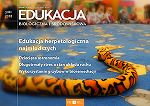Dziecięca astronomia
Children’s astronomy
The predominant mental models of the shape of the Earth, the location of people on Earth and the phenomenon of day and night in children from 5 to 10 years of age
Author(s): Jan Amos JelinekSubject(s): Preschool education, Pedagogy
Published by: Instytut Badań Edukacyjnych
Keywords: children’s astronomy; mental models; astronomical concepts; pre-school children; students of grades I-III (ISCED I); explanatory theories; naive ideas;
Summary/Abstract: The shape of the Earth, locating people on the surface of the planet and explaining the phenomenon of the shape of the Earth are some of the key issues for children to accept scientific explanations about astronomy. On the basis of research (Jelinek, 2017) it was found that the mental models of Polish children are similar to those presented by children in other countries (Vosniadou i Brewer 1992, 1994). This article presents research aimed at determining the frequency of individual mental models in different age groups (N = 444). Studies have shown that the number of correct indications of scientific models increases with age. Already 15.2% of the examined children in age of five and six years gave scientific explanations regarding the astronomical issues discussed. In turn, 1/3 examined children in age of the 9 and 10 year-old cannot properly explain the phenomenon of day and night.
Journal: Edukacja Biologiczna i Środowiskowa
- Issue Year: 2018
- Issue No: 3
- Page Range: 22-29
- Page Count: 8
- Language: Polish

